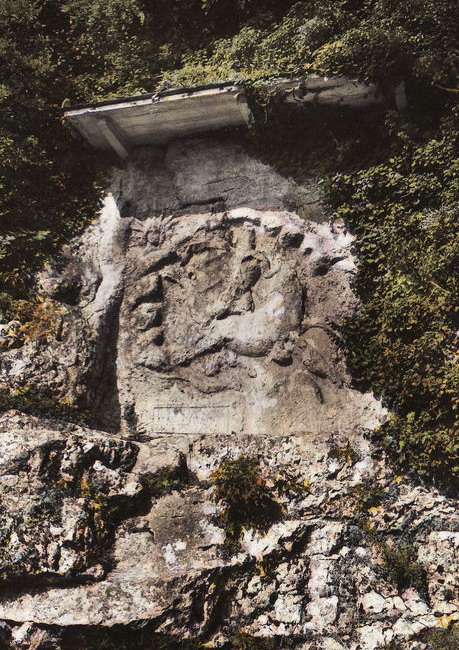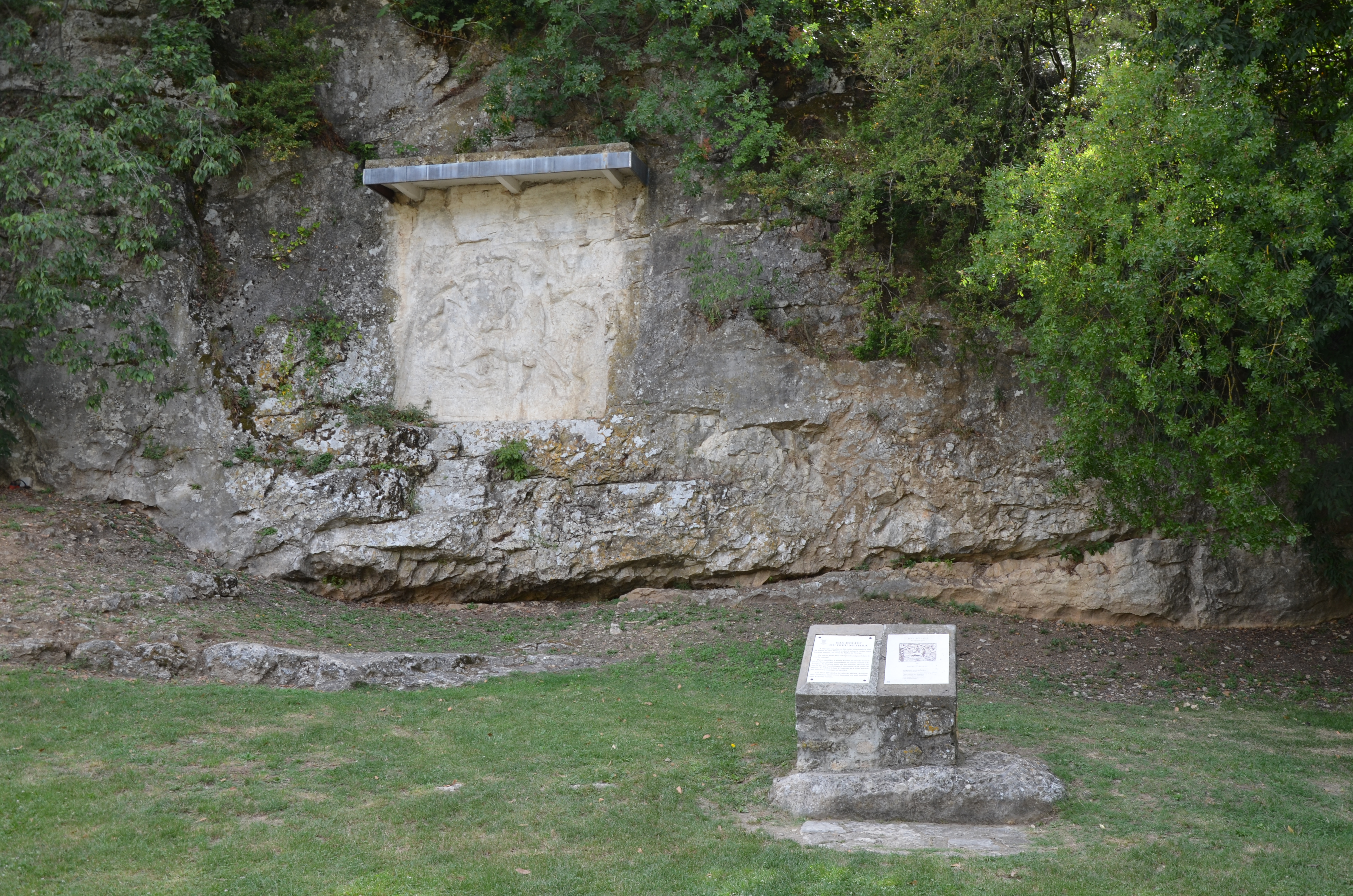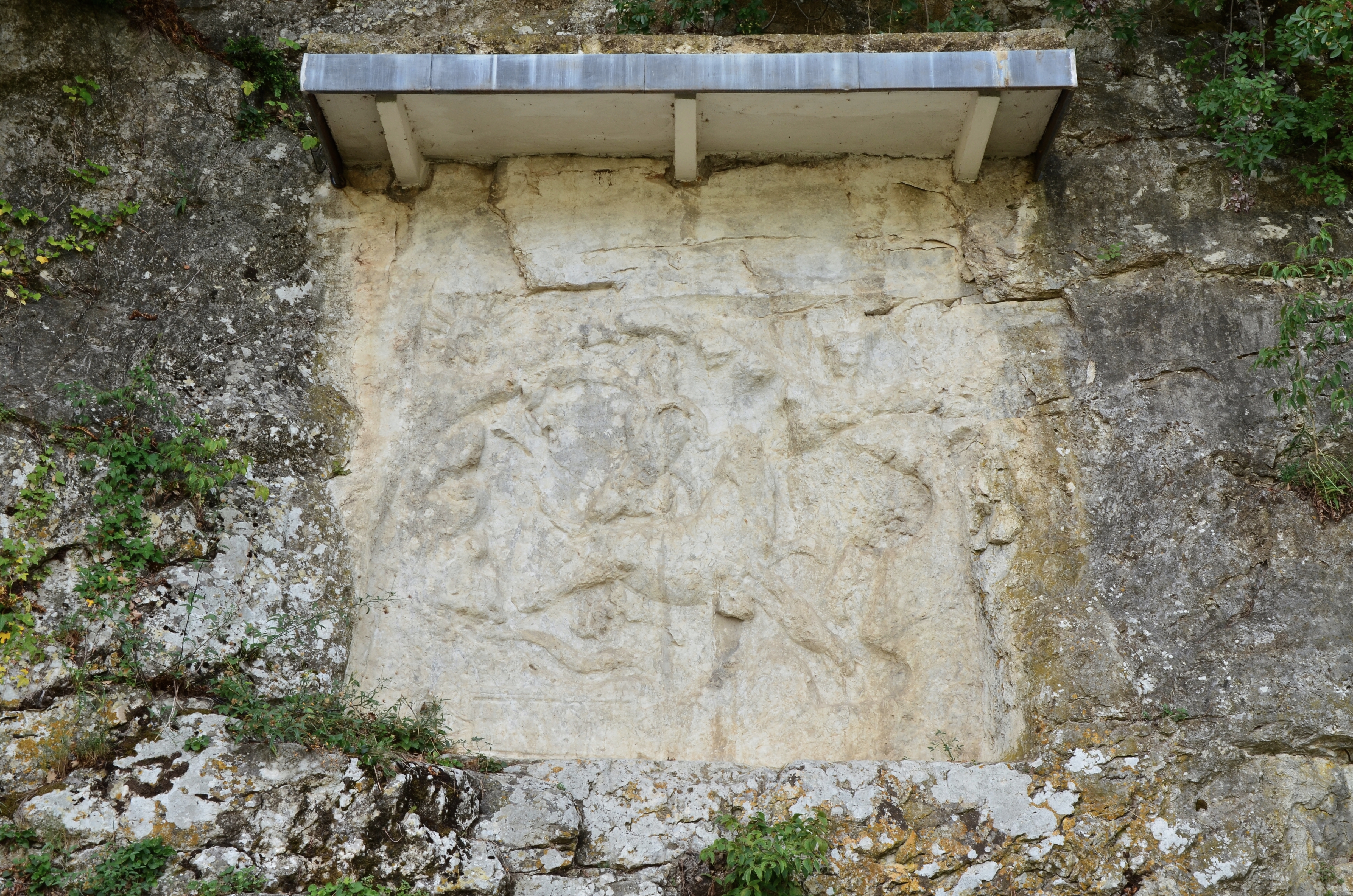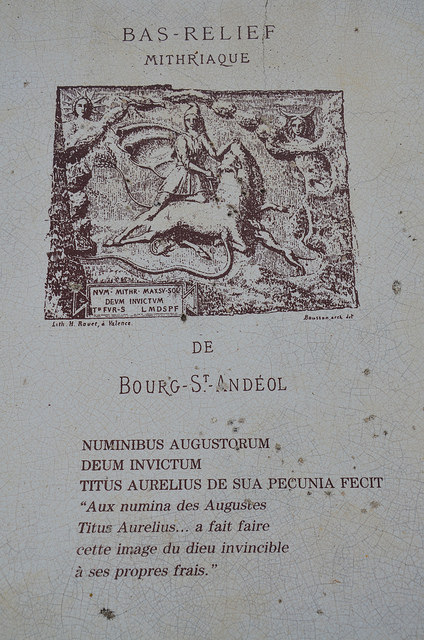
CIMRM 895, 896, 897 - Mithraeum and cliff-face tauroctony relief. Bourg-Saint-Andéol, France.




Bas-relief dedicated to the god Mithras, sculpted in the rock, 3rd century AD, Bourg-Saint-Andéol, France.
1.30 meters long and 1.15 meters high, it is the only bas-relief directly sculpted in the rock that can be seen in France. In the 3rd century, this bas-relief was indeed the back of a temple, Mithraeum, which went all the way to the riverside. The bas-relief was to be demolished in 1880, when the railroad was built, but Priest Paradis was strongly opposed to this decision. He managed to have it preserved and protected.
CIMRM entry
BOURG-SAINT-ANDEOL
895.
A rock, situated not far to the West of Bourg-Saint-Andéol.
Caylus, Rec. Ant., III, 343; Millin, Voyage Midi, II, 116; Rouchier, Hist. Viv., I, 159; MMM II 401, No. 279; Esp. Rec. Gaule, I, 286 No. 422.
From various, often unreliable and scarce data, we may yet safely accept, that it really is the back-part of a Mithraeum. The rockface, in which the relief (see below) has been chiseled out forms the back-wall of the sanctuary, which lies against the mountain. Above the relief two grooves are hewn out, creating the impression, thafthe roof had been fitted into them. Of the sanctuary itself nothing was found back. At the foot of th" rock, there are two fountains, the water of which pours out into two basins. Between the springs there were, according to Caylus, "les restes d'une table d'autel formée par le roc".
896.
Relief, hewn out in the rock (H. 1.50 Br. 2.00).
Guillemeau, Mém. S. And., 297ff; Lancelot, Hist. Ac. Inscr., VII, 1733, 238; Menard in Mercure de France, Mars 1740, 411ff; Caylus, o.c., 342 and Pl. XCIII-IV; Millin, o.c., Pl. XXVIII, 2; (cf. JS 1781, 798); de Laborde, Mon. France, I, 79 and Pl. LXV; Rouchier, Rel. B. S. And.; Hist. Viv., I, 159ff; Lajard, Intr., LXXXVII; Perrot, Lettres Nimes, I, 361 and fig. 52; Mirabel, S. And., 52 and Pl. I; MMM II l.c. and fig. 323; Esp. Rec. Gaule, I, 287 and fig.; Sautel-Imbert, 159.
In a cave Mithras as a bullkiller. He is dressed in a flying cloak. The dog and the serpent near the wound; the scorpion at the testicles; the raven is perched on the border of the rock. In the upper corners Sol (l) in nimbus and radiate crown, and Luna (r) with a crescent on her head.
In the left lower corner, in a frame, an inscription:
897.
CIL XII 2706; MMM No. 501.
Num[ini] ... v .. / deum invictum / T. Fur(ius) Iu[stus?] d(e) s(ua) p(ecunia) f(ecit).From the martyrology of St. Andeol (died in 202 A.D.) it might be concluded, that the sanctuary was in use in the beginning of the third century (Cumont).
Emile Thévenot was so kind to write me the following lines: "Un de mes correspondants qui a visité le site de Bourg d'Andéol, et examine minitieusement le bas-relief dans les meilleures conditions d'éclairage, me communique une serie d'observations en grande partie inéditees et interessantes:
1) l'orientation de la falaise est telle que les meilleures conditions de visibilité se trouve realisées a l'équinoxe.
2) la figure solaire offre 11 rayons (et non 9).
3) la figure lunaire est surmontée non pas d'un croissant, mais de deux cornes de taureau et une oreille est celle d'un taureau".
There are many more details in Cumont, vol 2, #279 (p.401-2). This specifies that the Acts of S. Andeol may be found in the Acta Sanctorum 1st May, vol. 1, p.38. Andeol was arrested, according to the account, by Septimus Severus who ordered him imprisoned and said, "Quaerite locum tenebrosum et squallidum, ubi nullum lumen appareat, ibique eum recludite... Tunc unus de militibus, Cerecius nomine, dixit ad Caesarum: Domine, est in alia ripa fluvii coeptum fieri templum invictissimi Martis, sub ipso est crypta constructa, in qua si iubet Magnitudo tua, tutissime poterit iste recludi ... Jubente ergo Severo ductus est homo Dei et in crypta daemonibus dedita impie trusus." ("Find a dark and squalid place, where no light enters, and imprison him there ... Then one of the soldiers, named Cerecius, said to Caesar, 'Lord, there is in another valley of the river a temple begun to be made of the most invincible Mars, under which a crypt has been made, in which, if it pleases your Magnitude, he can be safely imprisoned ... Rejoicing therefore the man of God was led by Severus and held in the crypt impiously given over to demons.") On p.26 the Bollandist editors comment that "haec crypta sub templo Martis exstructa antiquitatem non maximam sapit: Quia Christianorum et quidem iam pacate agentium fuit, non gentilium, aedificandis templis cryptas substruere." (i.e. pagans didn't build underground temples). Cumont comments that this supposed anachronism is easily explained by supposing that it was a confusion of MARTIS and MITHRAE, and that, supposing this, this would date the Mithraeum to the start of the 3rd century.
This is very erudite of Cumont, but how likely is it that the Acta of St Andeol are that ancient?
| Tweet |